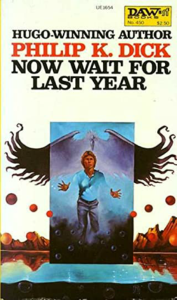“Now Wait for Last Year” (written in 1963, published in 1966) is narratively about an intragalactic war between three races and drug-induced time-travel. Yet it’s clear that the issue most on Philip K. Dick’s mind was his relationship with his wife (and perhaps past relationships with past wives and girlfriends).
Successful but self-loathing
Eric Sweetscent is one of the most successful PKD protagonists, a doctor who is specifically recruited by UN Secretary General Gino Molinari (nicknamed “The Mole”) – the equivalent of the president of Earth in 2055.
(In fact, Molinari works out of the White House, although it’s now located in Cheyenne, Wyo. – which is funny, but also a pretty good idea for unclogging the political swamp in D.C. Perhaps this society uses a rotating location for the Earth’s capital.)

“Now Wait for Last Year” (1966)
Composition year: 1963
Author: Philip K. Dick
Genre: Science fiction
Setting: Earth, 2055
Although the implanting of artiforgs (artificial organs) is hilariously easy – at least to the doc himself – Eric has obviously done something right to climb the ranks of his profession and to become so good at his specific skill. Nonetheless, he loathes himself.
Most humorously, this is illustrated when he converses with his own self from different time periods, and neither Eric can stand the other one. (This conceit was also used in a Season 3 episode of “Westworld” with William.)
It seems to me that someone who hates themselves would perhaps feel bad for another version of themselves, because they’d feel like they created that poor soul (if it’s the future version) or have let him down (if it’s the past version). But I admit that the open hostility between the various Erics is funnier.
Marital issues
Because Eric is successful in his profession, “Now Wait for Last Year” is a rare PKD work that is all about the psychological reasons for self-loathing, rather than depression and malaise coming about from living in a dystopian world that offers few prospects.
In a Chapter 4 scene between Eric and his wife, Kathy, she rips into him for not being professionally successful enough and tears down his hobby – collecting and watching old comedy tapes – as being childish.
The novel does an excellent job of illustrating how someone you love can dole out the sharpest barbs, and also how women can control men. The latter point is also seen via the teenage mistress who is the only one who can inspire Molinari to get out of bed.
In fact, Eric’s love for Kathy – and PKD’s love for the wife he hates – is the final statement of the novel, although it’s noteworthy that the author turns her into a brain-dead vegetable in order for Eric’s sympathy to be pure rather than the upswing on a rollercoaster of feelings.
Kathy had taken too many doses of the drug that allows for time-travel, but at the cost of destroying her mind. We would later see in “A Scanner Darkly” that this punishment for drug experimentation is not something PKD would wish on his worst enemy.

Drugs and power
The Mole also uses the drug – off page – to stay in power. Unlike Eric’s irritation at his alternate selves, The Mole is on the same wavelength with his alternate selves, and he (they) devises a plan to maximize his time in office.
Expert surgeon Eric is on hand with artiforgs, and in addition, The Mole can replace himself with a healthier version of himself from another timeline. A political player in “The Simulacra” also manipulates timestreams, but there it’s a funny aside; here, PKD digs into The Mole’s machinations, goals and consequences.
I wonder if The Mole is an intentional parallel to the similarly named The Mule from Isaac Asimov’s “Foundation” series, which launched two decades prior. Both The Mule and The Mole can shape history by confounding predictions.
In addition to frustrating data analysts, The Mole also has his own insight into the war that involves Terrans, ’Starmen and reegs. Eric respects The Mole’s higher station – and presumed greater knowledge — enough that he thinks he’s doing a civil service by seeing that Molinari stays alive.
But he doubts the secretary general as events unfold. Not surprisingly, it’s a rather random 19-year-old woman whose offhand analysis makes Eric doubt his motives and question the wisdom of Molinari.
Entangled alliances
More broadly, “Now Wait for Last Year” is the Jeffersonian warning about entangling alliances made manifest. The ’Starmen are the Terrans’ allies, but they are using humans for slave labor. The reegs are the enemies, but in the future glimpsed by Eric, reegs and humans live peacefully.
I dig PKD’s portrayal of time travel in this novel. It’s bats*** insane, yet graspable. It’s kind of like how Doc Brown approaches time travel in “Back to the Future”: He has theories, but basically he learns as he goes.
Both docs – Brown and Sweetscent – know the consequences of time travel (brain damage in this book’s case), yet they do it anyway. In Brown’s case, it’s to correct a previous mix-up; in Eric’s case, it’s out of a desire to see a greater good for mankind accomplished.
“Now Wait for Last Year” does not boast many things that can’t be found in other PKD books. (As another example, the cabs with personalities – similar to those in “The Game-Players of Titan” – provide regular doses of comic relief.)
But everything flows together nicely, and a reader’s knowledge of other works is a feature, not a bug. For instance, a mystery is created about the nature of the alternate Moles: Are they perhaps simulacra, a standard element of PKD’s catalog?
Even though the author’s preoccupation with his spousal relationship points to his own psychological issues, it plays quite well. It’s not randomly peppered in this novel, like it is in “Clans of the Alphane Moon.” Kathy is always on Eric’s mind, even when he’s trying to choose the right path for saving the human race – and isn’t that the way it is with love?

